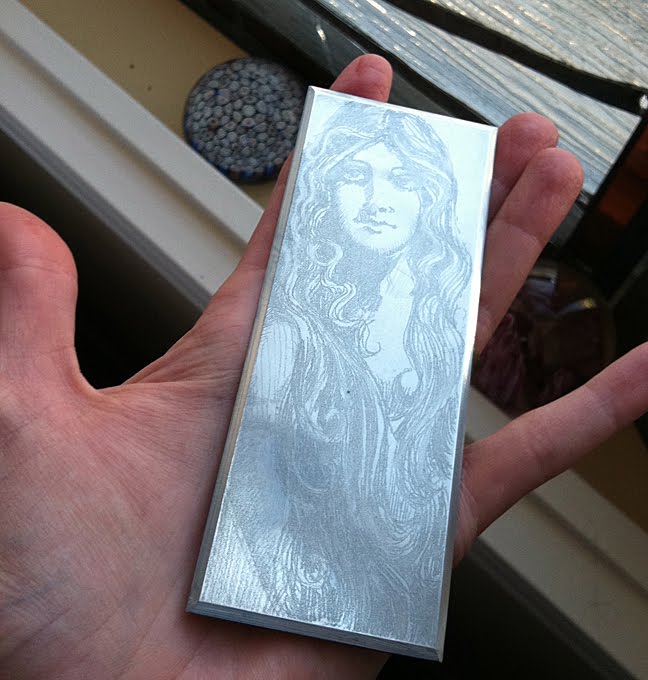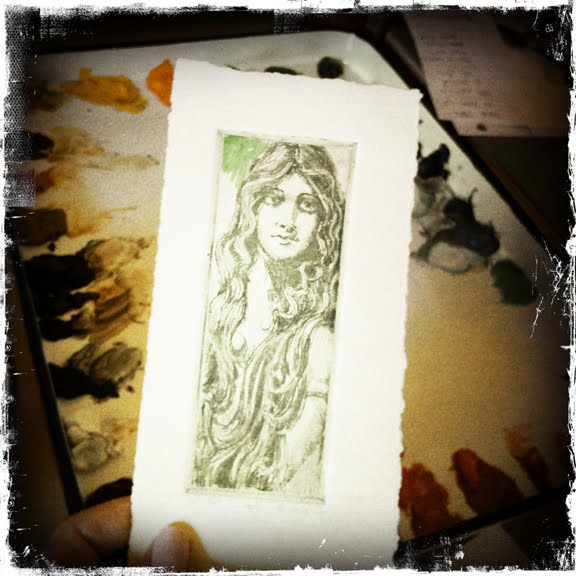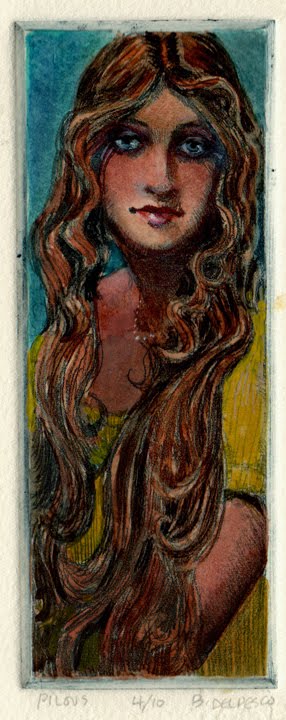
Making a Miniature Portrait with Soft Ground Intaglio Etching in a Zinc Plate
This (above) is the plate Pilous was printed from. It was originally someone else’s castoff – a scrap piece of zinc under the metal cutter in the print lab I was using at the time.
I beveled the edges with a rasp, and various files, and then polished the surface of the plate with finer and finer sandpaper and grit paste till it reflected a mirror shine.
The reasons for all of this pre-etch prep work are two-fold: 1) a beveled plate won’t cut your paper when it’s going through enormous pressure from an etching press (and it leaves a lovely plate impression in the paper), and 2) the surface of both the bevel, and the plate itself should be so smooth that ink doesn’t stick to it when you wipe it from the plate.
There are more details about etching online, and in some of my previous posts (like this post on intaglio etching).

Etching Post Round Up
- This post features another vintage image – from a 1950’s photo my great uncle took of an archery exhibition. For details about making a drypoint engraving in plexiglass, have a look at this.
- Making your first drypoint from plexiglass is easier if you start small, and pick a single item, like this peacock feather.
- If you’re looking for resources to learn how to print etchings, drypoint, collagraphs, and linocuts without a traditional press, this post of full of alternative ideas.
- This post is a round up of etching experiments printed from home, without a press, using recycled clear plastic produce and food containers. Get the details so you can print etchings at home here.

Small Etching Prints
Working small on your first etching or drypoint prints give you a chance to finish fast, keep the design simple, and print it at home without a press. If you’re lucky enough to have a printmaker friend or family member, reach out and ask them for advise or directions. You can also peruse this playlist of intaglio print tutorials from my YouTube channel.
Either way, have a ton of fun, and be sure to leave links to your results in the comments so we can cheer you on!
Thanks for stopping by and I’ll see you in the next post!
Belinda
Art Quote
An Architect without a very refined knowledge of drawing, must be classed among the handicraft occupations of stonemason and bricklayer; for architecture is nothing more than drawing or design made manifest in some kind of building materials, added to a practical knowledge of the materials employed.
In the splendid ruins of ancient temples, and the more perfect remains of gothic structure yet existing, there are abundant and intrinsic evidences of the draughtsman and builder being one person. The perfect unity of design and execution which pervades these remains, is alone sufficient to prove it; and it must be regretted, for the sake of architecture, that at the present day the draughtsman and builder are so frequently separate persons, as the odium, should there be cause for any, is too easily shifted from one to another, and the merit, when it exists, is either too much divided to possess any real value, or perhaps absorbed by the one least entitled to it.
Painting is the least generally understood of all the arts and sciences, and the reasons are obvious. The first arises out of the absence of a well regulated instruction in those places where instruction in all liberal knowledge ought to abound; where in every other department of knowledge it is most abundant; and where, if the proper study of painting or designing could be added, some students, by it, might be induced to think, when all other branches of learning, human and divine, had been tried in vain, and thus occupy some of those hours devoted by many to pursuits of a much less meritorious description.
The exquisite charms of poetry and music render them worthy of all the honours they receive in our universities; and were painting as generally understood, it would be equally favoured, for it has also its peculiar uses and charms. Its pleasures are conveyed to the mind through the sight a sense that affords to us the purest and least alloyed of all our enjoyments; and most are aware, that knowledge acquired by vision is more perfect, and more lasting, than any which is acquired by the other senses.
~On the Theory of Painting, Theodore Henry Fielding, 1836

So glad I found your blog. I very much enjoyed print making course at my university. I tried wrapping all my tools, but I would inevitably cut up my fingers caving into that copper. I never really got the hang of etching though (I’m so, so).
This is a lovely piece,
Nick
Hi Belinda…fantastic piece!!! If you have not already looked into Solarplate etching, you should. No acid and perfect for you. Just put one of your wonderful drawings to clear plastic and you are on your way!
John
It is amazing what you do with your prints and watercolors. Just gorgeous.
Just lovely, Belinda! She really catches one’s eye and heart. xo
She’s stunning! I learned plate etching in high school, but it’s been a long time. This brings back memories, for sure:)